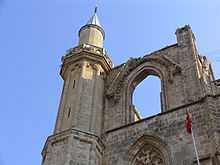Lala Mustafa Pasha Mosque

The Lala Mustafa Pasha Mosque originally known as Saint Nicholas's Cathedral and later as the Ayasofya (Saint Sophia) Mosque of Magusa, is the largest medieval building in Famagusta, Northern Cyprus. Built between 1298 and c. 1400, it was consecrated as a Catholic cathedral in 1328. The cathedral was converted into a mosque after the Ottoman Empire captured Famagusta in 1571 and it remains a mosque to this day.
History
Early history
The French Lusignan dynasty ruled as Kings of Cyprus from 1192 to 1489 and brought with them the latest French taste in architecture, notably developments in Gothic architecture.
The cathedral was constructed from 1298 to 1312 and was consecrated in 1328. "After an unfortunate episode when the current bishop embezzled the restoration fund",[1] Bishop Guy of Ibelin bequeathed 20,000 bezants for its construction.[2] The Lusignans would be crowned as Kings of Cyprus in the St. Sophia Cathedral (now Selimiye Mosque) in Nicosia and then crowned as Kings of Jerusalem in the St Nicholas Cathedral in Famagusta.[3][4]
The building is built in Rayonnant Gothic style, quite rare outside France, though "mediated through buildings in the Rhineland".[5] The historic tie between France and Cyprus is evidenced by its parallels to French archetypes such as Reims Cathedral. Indeed, so strong is the resemblance, that the building has been dubbed "The Reims of Cyprus"; it was built with three doors, twin towers over the aisles and a flat roof, typical of Crusader architecture.
Ottoman Era

The upper parts of the cathedral's two towers suffered from earthquakes, were badly damaged during the Ottoman bombardments of 1571, and were never repaired. With the Venetians defeated and Famagusta fallen by August 1571, Cyprus fell under Ottoman control and the cathedral was converted into a mosque, renamed the "St. Sophia Mosque of Mağusa".[6]
Islamic tradition prohibits the depiction of creatures or iconography; consequently, nearly all statuary, cruciforms, stained glass, frescos, and paintings were removed or plastered over, as well as most tombs and the altar. The Gothic structure was preserved however, and a few tombs can still be identified in the north aisle.
In 1954, it was renamed the Lala Mustafa Pasha Mosque after the commander of the 1570 Ottoman conquest- infamous for the gruesome torture of Marco Antonio Bragadin, the Venetian commander of the city's fortress. Bragadin had surrendered the city following a brutal 10-month siege in which 6,000 Christian defenders held off an army of more than 100,000 Ottoman Turks. A pledge of amnesty was secured from Lala Mustafa Pasha- who then reneged and had Bragadin beaten, his ears and nose cut off, publicly humiliated, and flayed alive.[7]
See also
- Rayonnant
- Saint Sophia Cathedral, Nicosia
- Lysi
- Conversion of non-Muslim places of worship into mosques
References
- ↑ Eileen Davey. Northern Cyprus: a traveller's guide. I. B. Tauris Publishers, 1994. Page 97.
- ↑ Adrian J. Boas. Crusader Archaeology: the Material Culture of the Latin East. Routledge (UK), 1999. Page 49.
- ↑ "Lala Mustafa Pasha Mosque (St Nicholas Cathedral) - Famagusta, Cyprus". Cypnet.co.uk. Retrieved 2013-10-06.
- ↑ "holidayinnorthcyprus Resources and Information. This website is for sale!". holidayinnorthcyprus.com. Retrieved 2013-10-06.
- ↑ Nicola Coldstream. Medieval Architecture. Oxford University Press, 2002. Page 13.
- ↑
- ↑ The Rough Guide to Cyprus, pp. 388-389
External links
| Wikimedia Commons has media related to Lala Mustafa Pasha Mosque. |
- Lala Mustafa Pasha Mosque (St Nicholas Cathedral)
- Cypnet page with sources relating to the Ottoman occupation and invasion plans
- Aerial photograph
- Flickr photograph
- Interior photo of the nave
- Cyprus travel guide
- St Peter and Paul Church (Sinan Pasha Mosque) Famagusta.
Coordinates: 35°07′29.27″N 33°56′33.40″E / 35.1247972°N 33.9426111°E